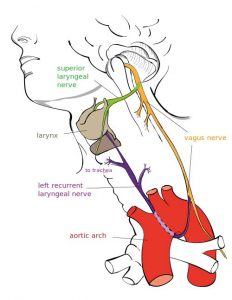What Happens in Vagus

And this illustration is just the half of it. The vagus nerve goes all the way from your head to your gut.
The vagus nerve is the 10th cranial nerve and it carries the most bi-directional information between the brain and the body of any other nerve. It initiates in the core of the brain and travels to the depths of the gut. Along its travels, it affects facial expressions, tone of voice, heart rate and heart rate variability, breathing, and the function of the spleen, liver, kidneys and intestines. It can help to reduce inflammation and to improve your immune response. It is the care-taking nerve of the body.
What it Affects
And the vagus impacts more than just physiological processes. When you say something is “getting on my nerves” or that you have a “gut feeling”, you’re referring to the vagus nerve. Through neuroception, a term coined by Dr. Stephen Porges, the vagus is assessing the safety of a situation and the mood of people you interact with. And that information is relayed to the brain.
The vagus nerve activates the parasympathetic nervous system. When the vagus is stimulated, it elicits the relaxation response. This slows your heart rate (through the release of acetylcholine) and relays instructions to release certain proteins and enzymes to calm you down. When you are relaxed, people can see it in your face and hear it in your voice because of the vagus nerve. You are better able to: concentrate, self regulate and connect with others when you are in this more calm and safe state. All thanks to the vagus.
Feedback received from clinicians in pilot studies suggest that the Dreampad and Focus System both engage the parasympathetic branch of the autonomic nervous system via the vagus nerve, via afferent fibers connecting to the ear drum and outer ear. The observed symptoms of relaxation and calm have been consistent across varied populations, including those with sleep, attention, trauma and developmental challenges.
Resources and Research
Here are some resources about the many functions and aspects of the vagus nerve:
- HRV and Vagal Tone article
- Social Engagement System and face-to- face communication
- Starting Spirals of Success
- A great Vagus Nerve Illustration from Psychology Today
- And the vagus nerve is at the core of the SSP intervention.



 © 2025 Unyte Health US Inc.
© 2025 Unyte Health US Inc.